
|
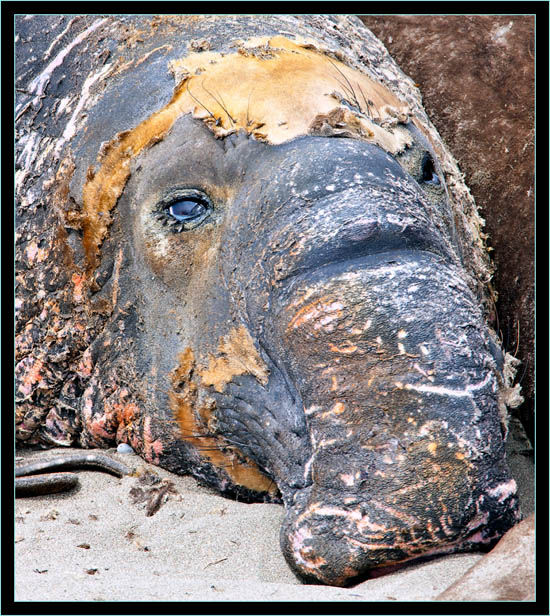
|
A friend in California regaled me with tales of time spent in the seal rookery, 'up the coast' from Santa Monica. I did some investigation to find out where the rookery was located and ended up on the
Friends of the Elephant Seal website. I'm going to provide information on these amazing creatures in this article, but freely admit I'll be referencing the 'friends' website - there's
a wealth of information available should you wish to learn more about their efforts and the rookery . I journeyed twice to the Piedras Blancas Elephant Seal Rookery, both day trips and long days as
the rookery is around two-hundred and fifty miles from Santa Monica. The rookery is located near Piedras Blancas Lighthouse on California's Central Coast, on Highway 1 between Los Angeles and San
Francisco. My first visit was in August 2012, a time of minimal seal activity, but when males haul up to molt - I found it worth the trip. The next time was more recent, January, 2013. This is a period of
high activity when the mothers and pups are in residence and males form their harems to repopulate the group. This article will display images from both trips.
Molting Male Elephant Seal - Piedras Blancas Rookery, CaliforniaCanon EOS Mark III 1Ds, 1/250 second; EF600mm f/4L IS USM +1.4x at f/11, ISO 400 |
Last fall, after being on a wait list for a time, I obtained one of Canon's newest professional bodies, the 1D X. This is known as a 'crossover' camera because it melded the 1D and 1Ds versions of Canon's professional
line to a single pro camera. For this trip I carried my long glass (600mm) tripod mounted with a 1.4X extender, a group of additional lenses at various focal lengths, the 1D X and my trustworthy Mark III 1Ds, which
was employed handheld. The image group in this article is a mix from both cameras.
Mother and Pup - Piedras Blancas Rookery, California...Canon EOS 1D X, 1/250 second; EF600mm f/4L IS USM +1.4x at f/11, ISO 400 |
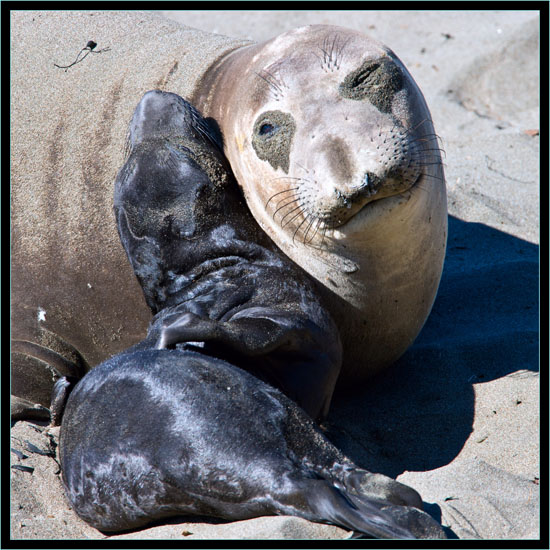
|
The Rookey in August - Males Hauled Out During Molt...
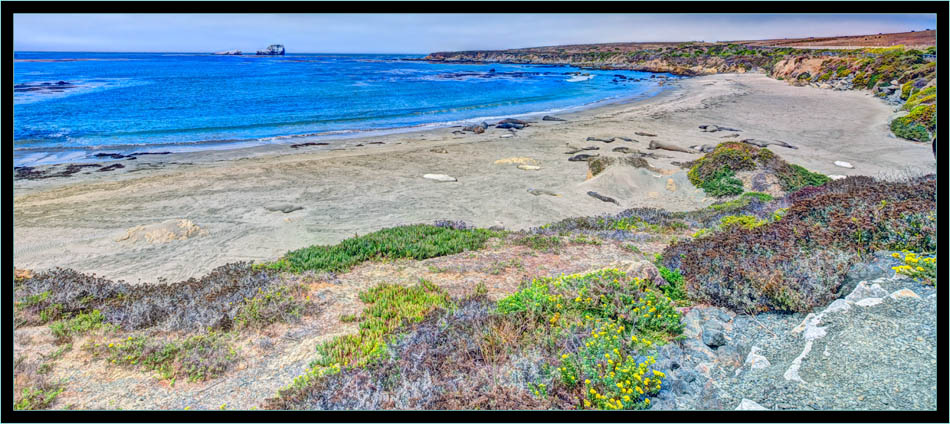
|

|
Last August, my first visit to the rookery, found few visitors to the site. Linda was in California visiting from home, Portland, Maine, and we made the journey together from Santa Monica. There were perhaps forty or fifty seals
present and most were on the beach in front of the parking area. Without a lot of people around I took the time to set up for some high dynamic range shots after taking some images on the seals at 840mm. It was a bit chilly
surprisingly, and the wind was up a bit. Not cold by Maine standards of course, but chilly enough that people stopping in to have a look did not dally long before getting back in their vehicles. Although this time of year did not
exhibit the uniqueness of the rookery filled with mothers and pups, it was still a terrific experience and we enjoyed the site not being as crowded as my recent January visit.
Beach R&R - Piedras Blancas Rookery, CaliforniaCanon EOS Mark III 1Ds, 1/400 second; EF600mm f/4L IS USM +1.4x at f/14, ISO 400 |
Elephant Seals are large oceangoing mammals who spend eight to ten months a year at sea - nearly eighty percent of their lives. There are two species, the Northern Elephant Seal (Mirounga angustirostris) and Southern
Elephant Seal (Mirounga leonine). The Piedras Blancas rookery is home to nearly seventeen thousand Northern Elephant Seals and trust when I state, it is an amazing location to visit. The seals make landfall to mate
and birth their young, as well as to molt and rest for further migration. Months when the seals haul out provide terrific opportunities for us two-legged mammals to observe and enjoy viewing these wonderful
creatures. Entry to the beach is prohibited and there are always docents and volunteer staff on site, so observing is not detrimental to the seals whatsoever from what I could see.
Male Elephant Seal - Piedras Blancas Rookery, California...Canon EOS Mark III 1Ds, 1/400 second; EF600mm f/4L IS USM +1.4x at f/11, ISO 400 |

|
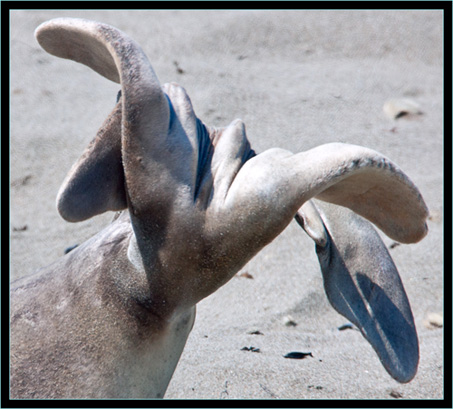

|
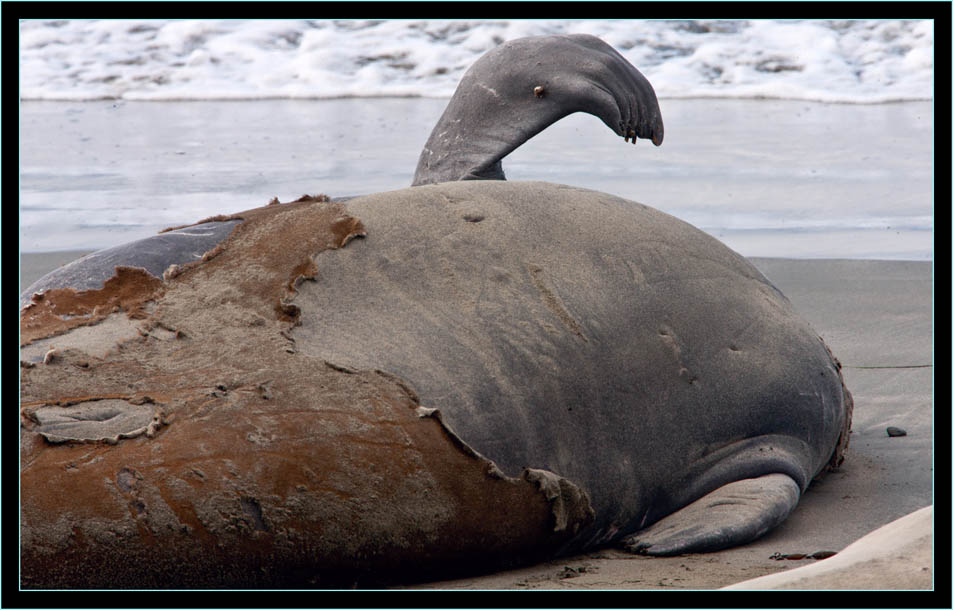
|

|
Elephant Seals, like so many creatures, were hunted to the brink of extinction in the nineteenth century. The blubber from these seals was known to be second in quality only to the Sperm Whale, making
them prime targets for ambitious sealers lighting their world. Fortunately, in the early twentieth century both Mexico and the United States implemented laws to protect the species. The United States
included Elephant seals in the Marine Mammal Protection Act of 1972, which has done much to allow the species to repopulate. It is estimated they now number over 170,000 individuals - an amazing comeback
considering near extinction with an estimated low of perhaps twenty to one-hundred individuals in 1874. Now that is a close call indeed, much to the shame of all humanity.
Male Elephant Seal - Piedras Blancas Rookery, CaliforniaCanon EOS Mark III 1Ds, 1/400 second; EF600mm f/4L IS USM +1.4x at f/14, ISO 400 |
Views Around The Rookery - August, 2012...

|
Return to the Rookey - January, 2013...
I kept an eye on the rookery website, where there is a calendar indicating peak times for seals on the beach. I made the trip in August because I did not think I would be around through early 2013, so viewed
still being in California as an opportunity. I talked with my friend Bob about making the drive and asked if he wished to join me. We managed to coordinate our schedules and ended up doing this on Martin
Luther King, Jr. Day, January 21, 2013. I left Santa Monica about 0530, picked up Bob at his residence an hour later and we headed for the coast. Other than stopping for a cup of coffee little time was wasted, although I started seeing a plethora of hawks along the highway which I found intriguing. Later, after we were on more or less secondary roads, areas where pulling off did not entail complete risk of
life and limb, we attempted to get some better views and a few exposures on the hawks. All of those we stopped to check out were Red-tailed Hawks. Always good to see these, but I was hoping for something
a bit more exotic to add to my Bird Photography Index. It was lengthy drive and we arrived at the rookery around 1100 hours.
Sounding Off - Piedras Blancas Rookery, California...Canon EOS 1D X, 1/250 second; EF600mm f/4L IS USM +1.4x at f/11, ISO 400 |
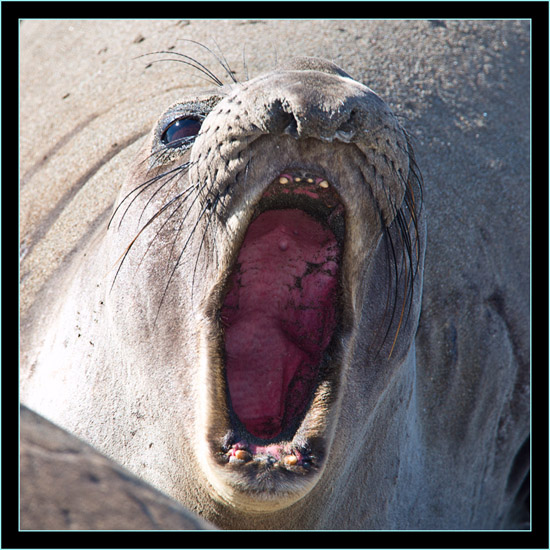
|
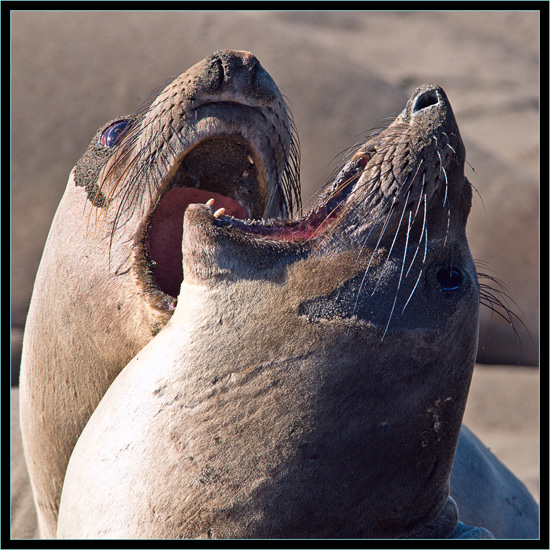
|
As we approached the parking lot several factors were readily apparent. The parking lot was jammed with cars and visitors were everywhere, and the position of the sun made the light on the rookery about as harsh
as could be. I was concerned about finding a place to park, but vehicles were leaving as the crowd changed over and we were able to find a spot that worked well to set the tripod up. I checked and readied the
cameras while Bob reconnoitered the beach near the parking lot. I did not mention previously in this article, but I always mount my flash and extender when in the field doing nature work, especially on days
like today where shadows would be exacerbated by harsh sunlight. The images in this article are a mix of exposures with and without flash. The 1D X camera has a quick burst rate, twelve frames per second, so
if shooting continuously the flash cannot recycle quickly enough to keep up. This works out well because in post processing you can view a similar scene with and without flash to compare and choose the best
selection from the repetitive exposures.
Female Elephant Seals - Piedras Blancas Rookery, CaliforniaCanon EOS 1D X, 1/500 second; EF600mm f/4L IS USM +1.4x at f/10, ISO 400 |
Bob had his camera along and we started by photographing a few individual seals more or less seeking solitude from the larger groups. This may have some social connotation about interaction with the other seals, but
we viewed it as an opportunity to test the lighting conditions. The rookery proper has a boardwalk nearby that runs parallel to the beach, allowing excellent, fairly close observations of the seals. Most everybody
present was either located on this boardwalk or moving to or away from it. As I looked at the location of the sun I recognized I would be on this boardwalk soon enough as well. There were few places to set up to shoot
into the rookery without exposing directly into the sun. Even with the constrained field of view on the 600mm lens on selected subjects this created a challenge. Shooting with higher magnifications from any platform
not rock solid is never a good idea. Conditions do not get much worse than on a boardwalk filled with people walking, kids running, etc., creating deflection and a significant detriment to razor sharp images due to vibration.
Carrying a tripod with a long lens around a crowd is also problematic as well, but besides everyone looking at Bob and me like we were from another planet it worked out okay. I never mind sharing views through the
lens and many people got to see some Elephant seals 'up close and personal' in the time we visited.Elephant Seal Newborn - Piedras Blancas Rookery, California...Canon EOS 1D X, 1/320 second; EF600mm f/4L IS USM +1.4x at f/10, ISO 400 |
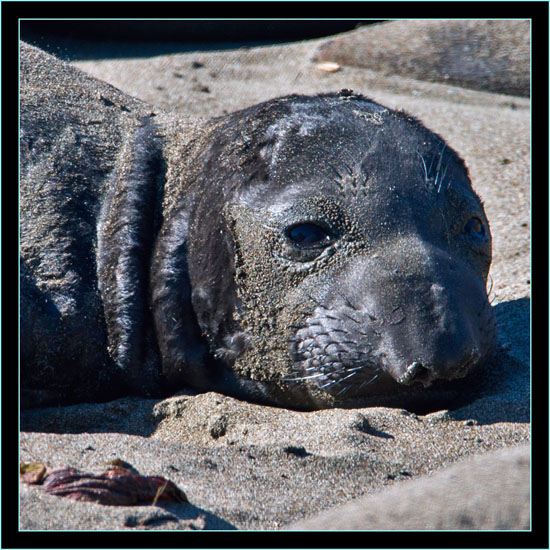
|
Rookey from the Boardwalk...
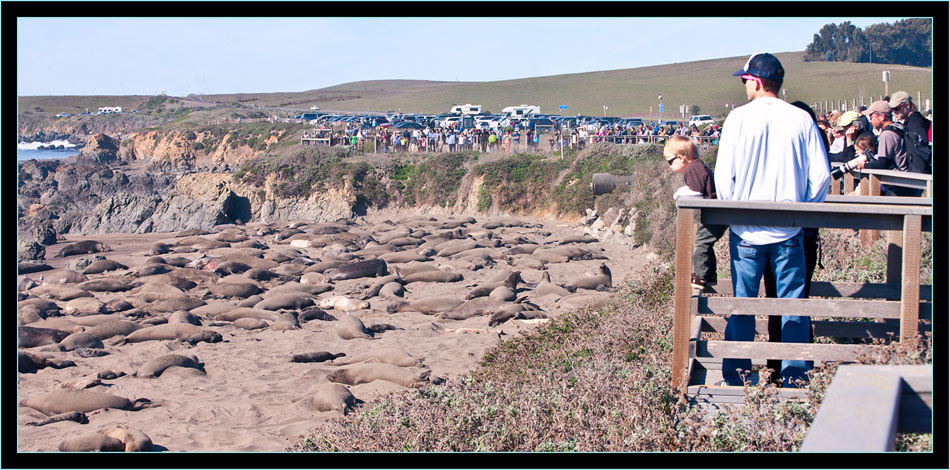
|
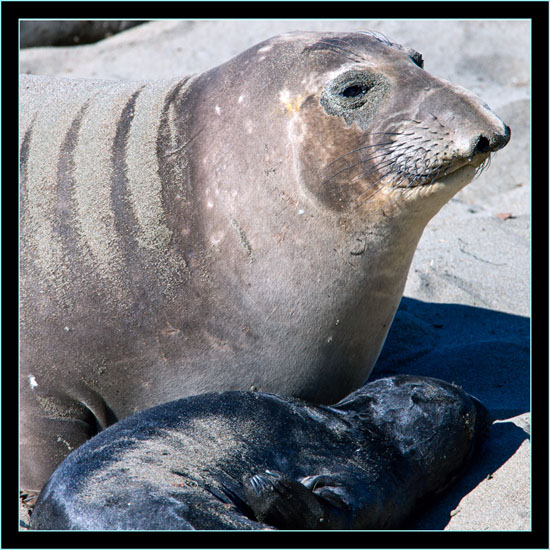
|
The Friends website indicates the mature bulls start arriving at the rookery in late November signifying commencement of the breeding season. The females start arriving in mid-December through the middle of February. Birthing
takes place as early as around Christmas but the peak is around the last weeks of January, when Bob and I visited. The docent we spoke with told us the pups are born in the mornings and afternoons. The more wrinkled a pup
appears, the newer it is. She also pointed out some of the little ones were born the very morning of our arrival. The pups at birth weigh between sixty and eighty pounds and nurse for twenty-four to twenty-eight days before
being weaned, when mothers head back to sea. The 'weaners' have experienced significant weight gain by this time and remain at the rookery for eight to ten weeks, learning how to swim before they head out to sea. The seals
fast while on land and can lose as much as a third of their bodyweight during the breeding season.
Mother and Pup - Piedras Blancas Rookery, CaliforniaCanon EOS 1D X, 1/250 second; EF600mm f/4L IS USM +1.4x at f/11, ISO 400 |
There is nothing quiet about observing the rookery. The seals are quite vocal and bellowing, grunts, trumpeting, squeaks, snorts, etc., presents a continual cacophony of noise and sounds. We could see why so many visitors take
time to investigate this site - it truly is unique and quite amazing. The alpha male seals form harems and are surrounded by females. Beta males remain on the periphery of the groups assisting the alpha males and
keeping less dominant males from the harem. The males will fight to exert dominance but when this occurs it is rarely a fight to the death. The large nose of the males is noted as a secondary sexual characteristic, a
marker of the physical and sexual maturity of individuals. Males are much larger than females and can achieve a size of fourteen to sixteen feet and weigh upwards of five-thousand pounds, reaching sexual maturity at
around nine years. Females grow to nine to twelve feet and weight between nine-hundred and eighteen-hundred pounds, reaching physical maturity around age six. These really are imposing creatures.
Rookery View - Piedras Blancas Rookery, California...Canon EOS Mark III 1Ds 1/500 second; EF70-200mm f/2.8L IS II at f/10, ISO 400 |
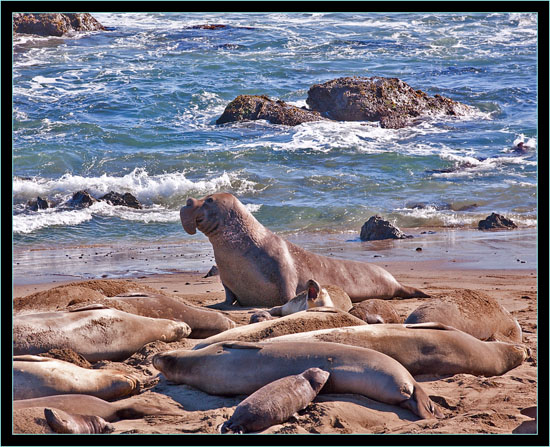
|
The Rookey in January...
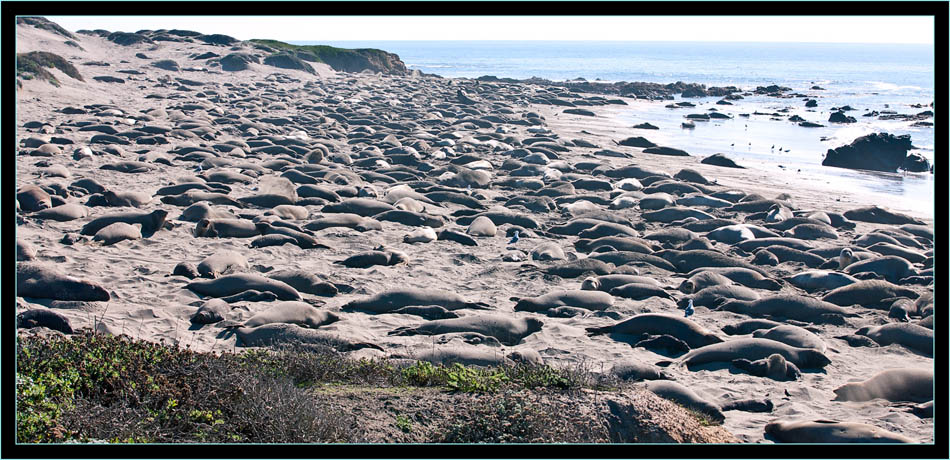
|
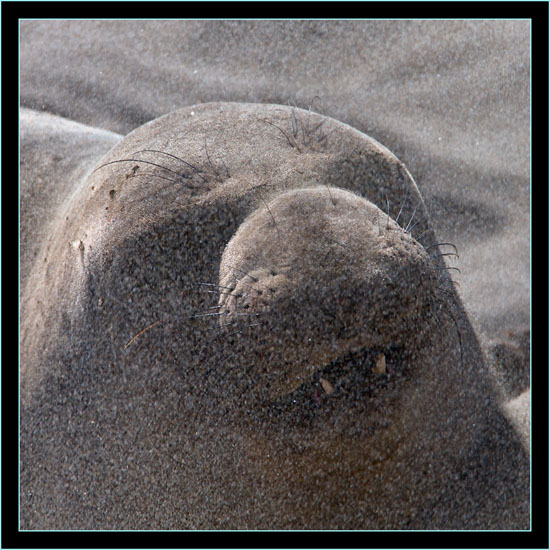
|
A typical inquiry voiced multiple times on the boardwalk, was about the seals behavior of sand flipping - covering their bodies with sand. You cannot observe the seals long without seeing this behavior. The docents
explained this to the visitors. Elephant Seal bodies are adapted for immersion in cold waters, using their layer of blubber to remain warm. On land with the sun shining down, they get too warm. Sand flipping helps
to cool their bodies and serves as sunscreen for solar protection. The website indicates this is also a mechanism used under stressful conditions. The seals had sand flipped everywhere and many of the exposures
with their mouths open indicate they must ingest quite a bit.
Sand Fall - Piedras Blancas Rookery, CaliforniaCanon EOS 1D X, 1/1000 second; EF600mm f/4L IS USM +1.4x at f/10, ISO 400 |
Seals in the Sand...
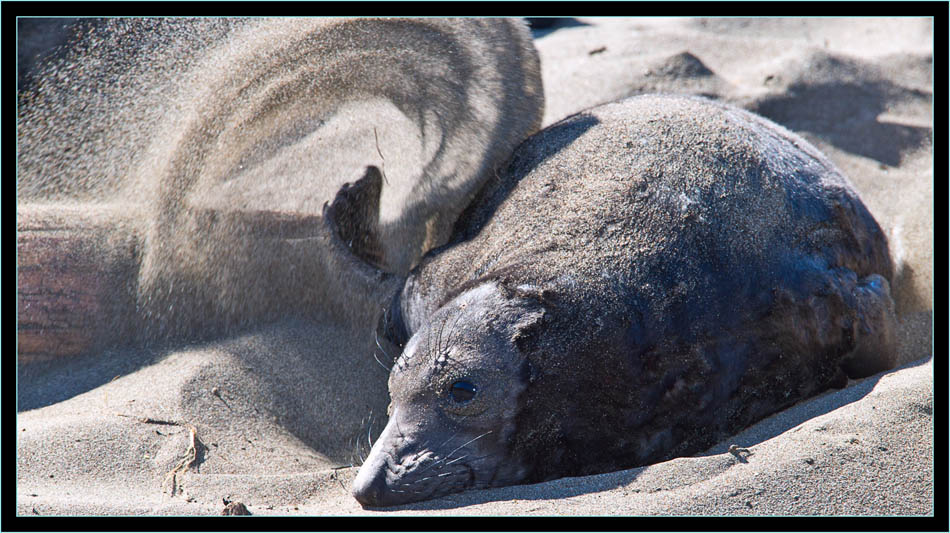
|
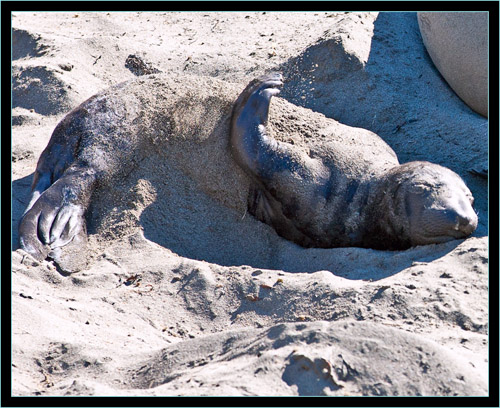
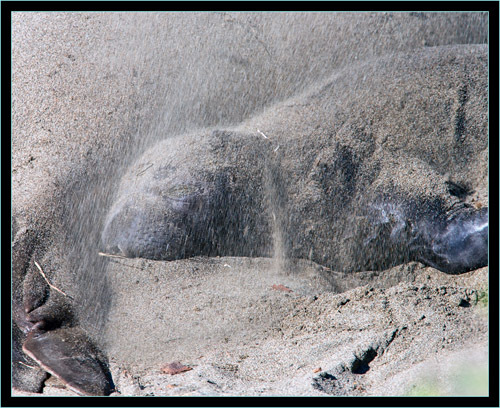
|
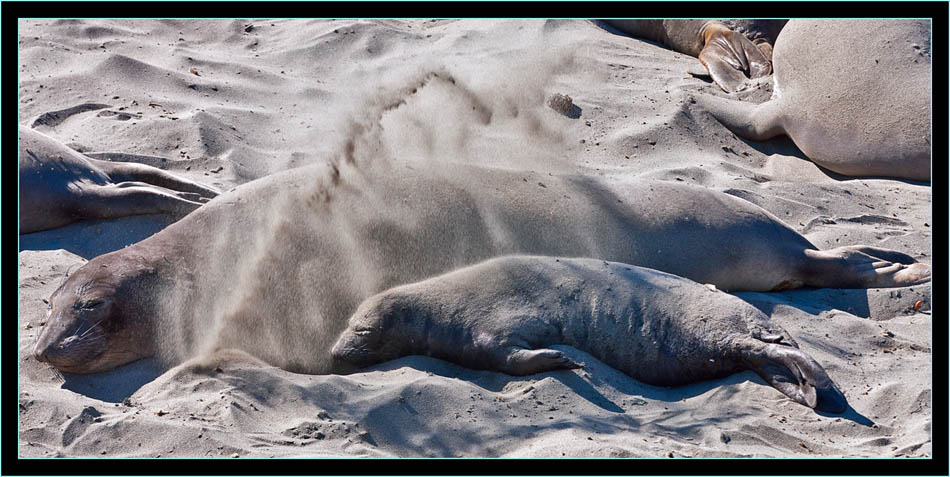
|
I found the lighting conditions to be a concern, so experimented with varied mode settings on the cameras to see what worked best. I shot in manual, did some exposures in program mode to see what the camera
was metering in the bright light, and eventually went to Aperture Priority, figuring selection of the f stop would be best. I was concentrating on the subjects and did not want to overthink camera settings. I
checked the histogram periodically to make certain the highlights were not blowing out and continued seeking subjects.
Elephant Seal Newborn - Piedras Blancas Rookery, California...Canon EOS Mark III 1Ds, 1/400 second; EF70-200mm f/2.8L IS II at f/10, ISO 400 at 160mm |
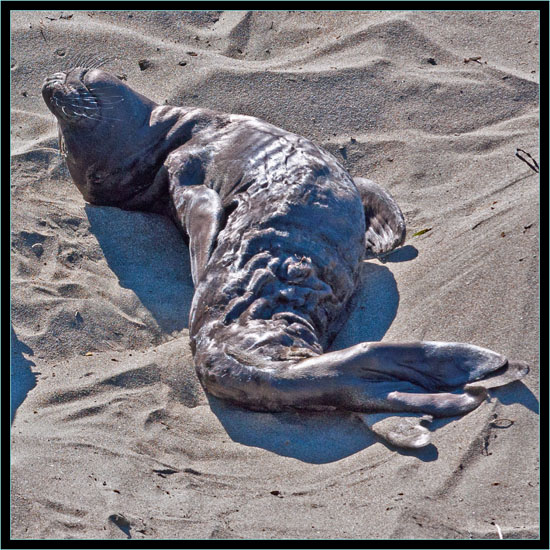
|
Rookery Views - January 2013...

|
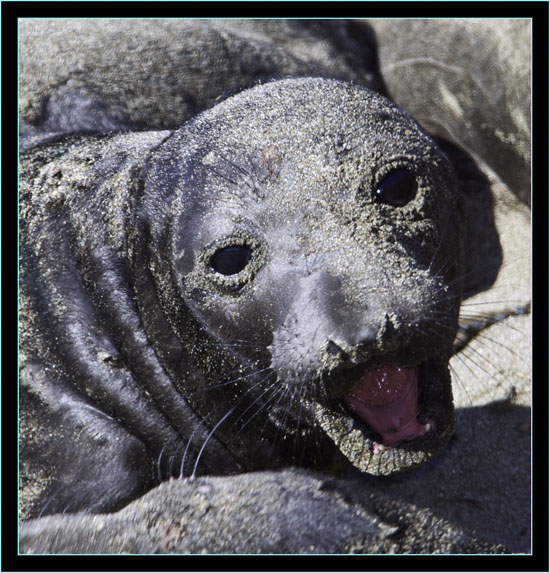
|
Seal mothers have a single pup. The website indicates if twins occur at all it is rare. With mothers losing a third of their body weight and nursing the young to around three-hundred pounds on extremely
nutritious milk, twins could prove a danger to the parent. It also notes that only one of seven pups will live to the age of four, poor odds by any measure. Elephant Seal males can live to around
fourteen years of age, females to about twenty years.
Elephant Seal Pup - Piedras Blancas Rookery, CaliforniaCanon EOS 1D X, 1/250 second; EF600mm f/4L IS USM +1.4x at f/11, ISO 400 |
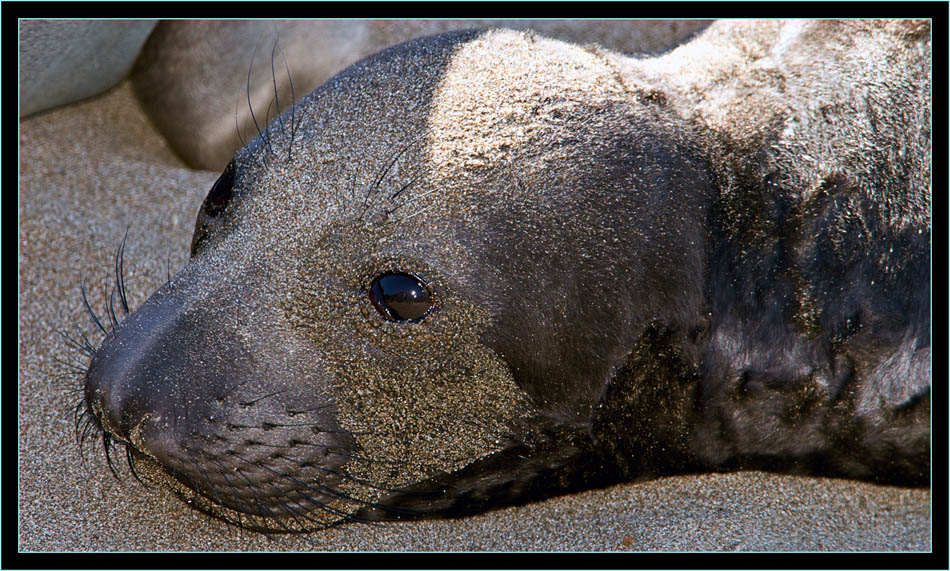
|
Seal Tails...
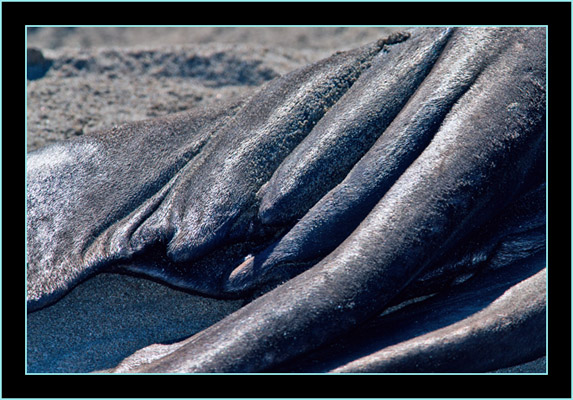
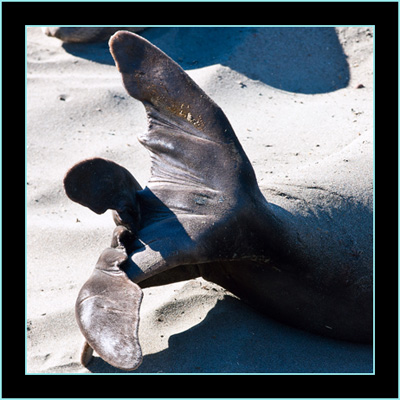
|
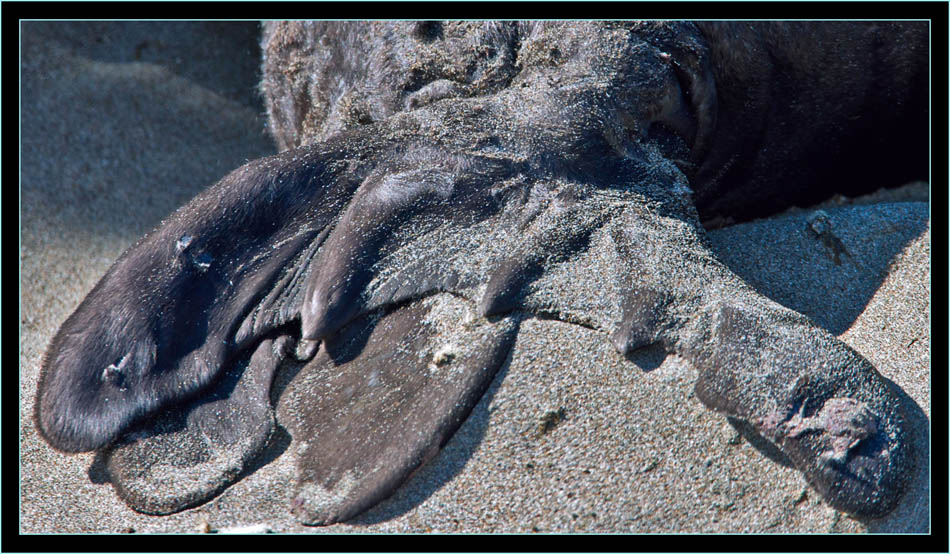
|
Males are present at the rookery during their molt, July and August and birthing and breeding seasons, December through March. The balance of the time is spent foraging on the continental shelf from Oregon to the Aleutian Islands of Alaska. The website indicates their primary food consists of bottom dwelling species and squid. They require about one-hundred pounds a day to support their large bodies; that is a lot of foraging on a daily basis. Adult and sub-adult males spend eight or nine months each year at sea. Females and juveniles, male and female, are at sea nearly ten months a year. Female seals eat primarily squid at sea. Elephant Seals can dive to great depths, as deep as five thousand feet, but it is noted the average dive depth is one to two thousand feet. Dives can last from twenty minutes to an hour, with a short interval of two to four minutes surfaced between dives. Because they are at sea so often and diving nearly all the time, ninety percent of their time at sea is spent underwater. These really are amazing animals.Male Elephant Seal - Piedras Blancas Rookery, California...Canon EOS 1D X, 1/500 second; EF600mm f/4L IS USM +1.4x at f/10, ISO 400 |
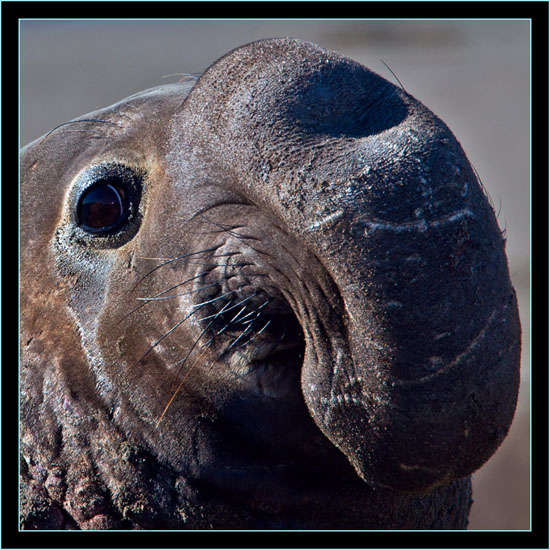
|
Males in the Rookery...
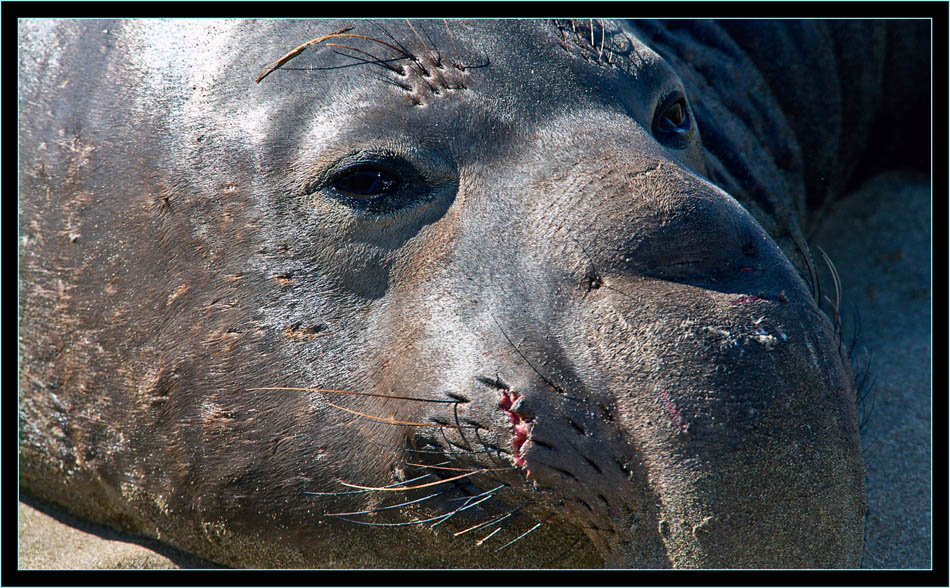
|
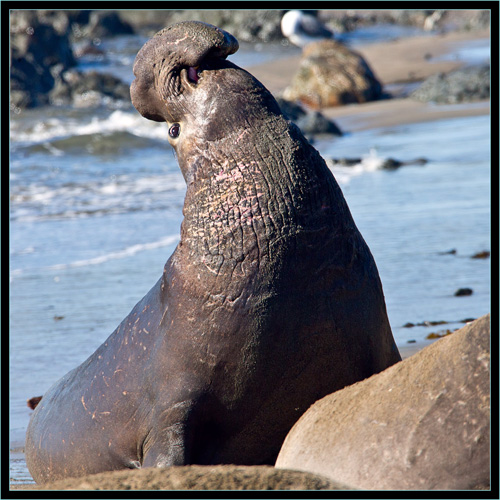
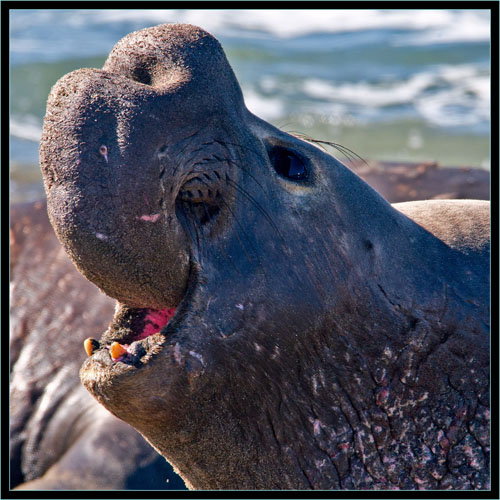
|
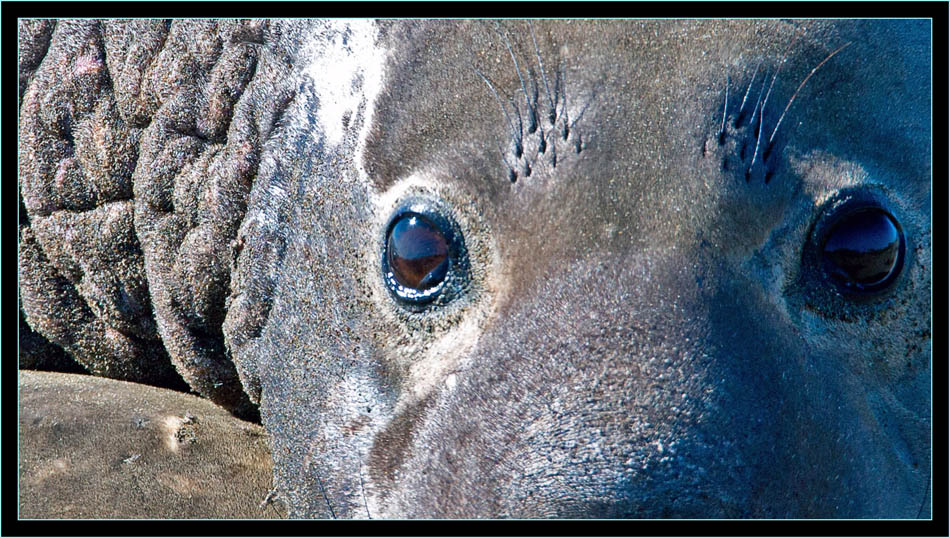
|
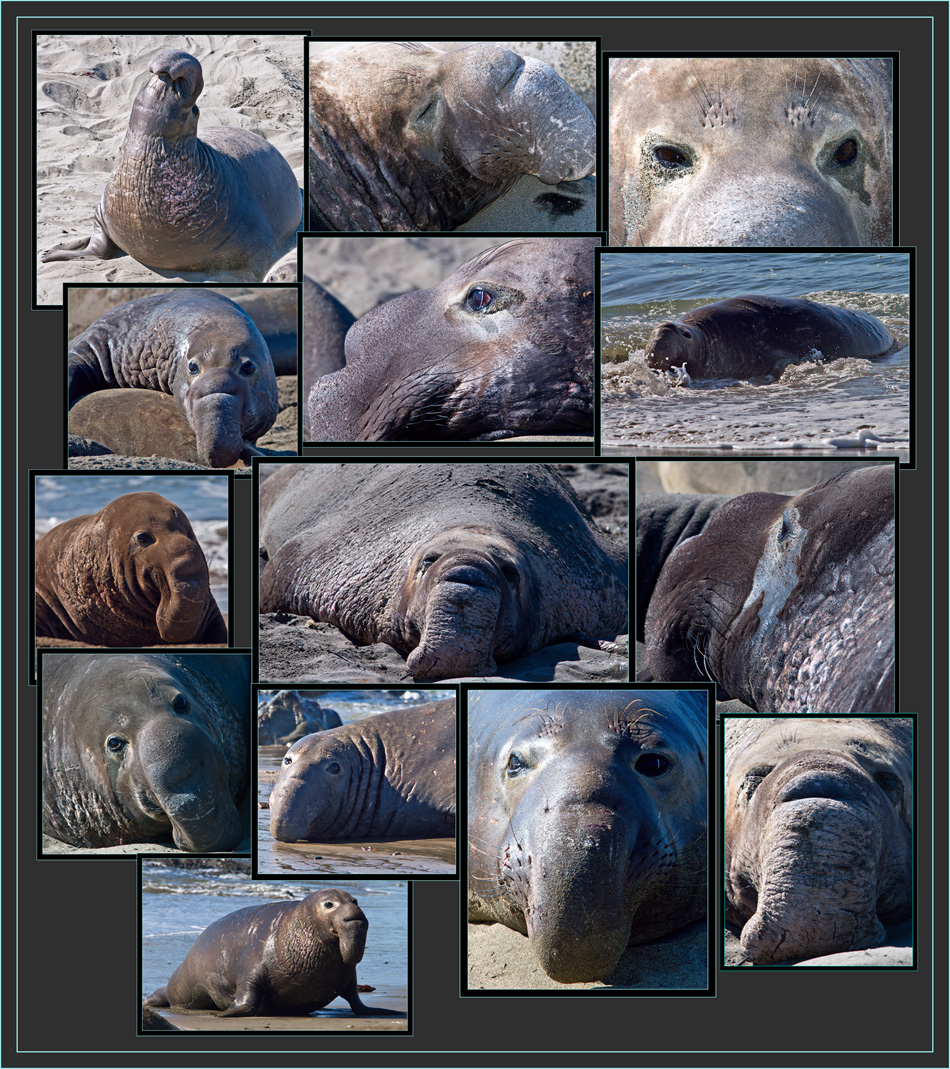
|
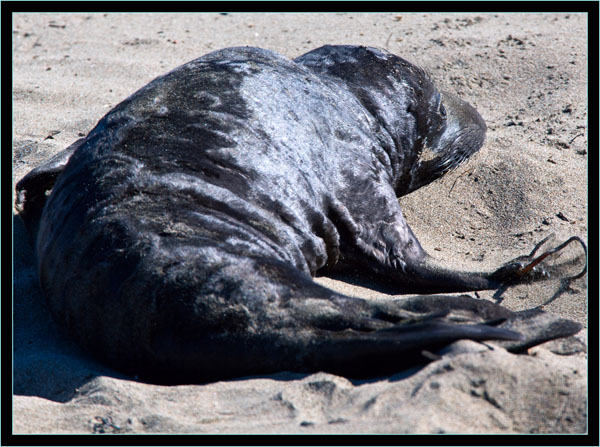
|
This rookery is located along a beautiful part of the coast and there were many people out and about enjoying it. It was a warm day in January and a holiday as well; folks were taking advantage of it. Nearby is
another major tourist attraction, Hearst Castle, which I am certain was on the same tourist circuit as stopping to observe the Elephant Seals. A short distance from the rookery is the Piedras Blancas Light Station. I
had talked with Bob about photographing the light in HDR, but both times I was in the area the entrance road was closed. I guess we were not on the same schedule. Although shooting at distance involved a good deal
of haze and atmospheric distortion, I took some exposures of the facility to add to my lighthouse exposures.
Elephant Seal Newborn - Piedras Blancas Rookery, CaliforniaCanon EOS 1D X, 1/400 second; EF600mm f/4L IS USM +1.4x at f/10, ISO 400 |
Piedras Blancas Light Station at Distance...
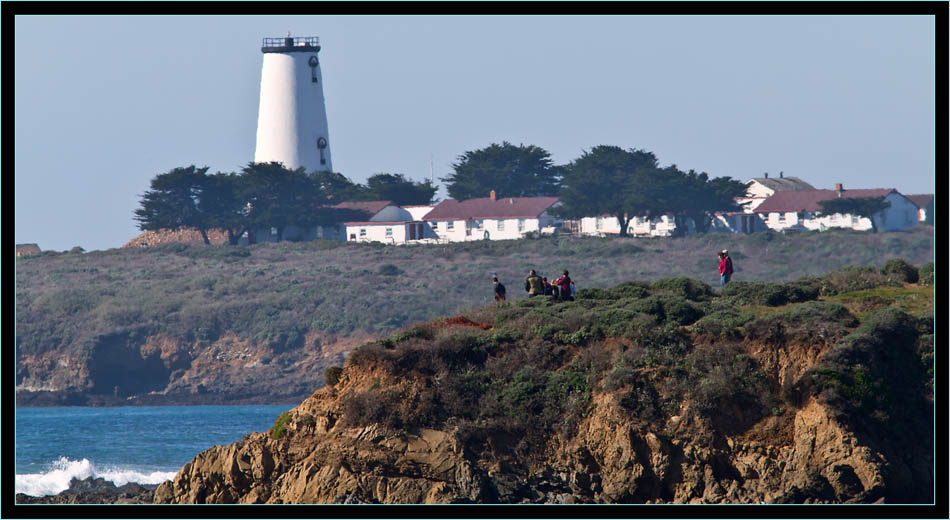
|
Now that humankind has stopped the slaughter of Elephant Seals, their greatest predatory concerns are Great White Sharks and to a lesser degree, Orcas. Most shark attacks occur near the surface of the water; the
website indicates this is the case with seal assaults, Great Whites attack from below.
Magnificent Males - Piedras Blancas Rookery, California...Canon EOS 1D X, 1/500 second; EF600mm f/4L IS USM +1.4x at f/10, ISO 400 |
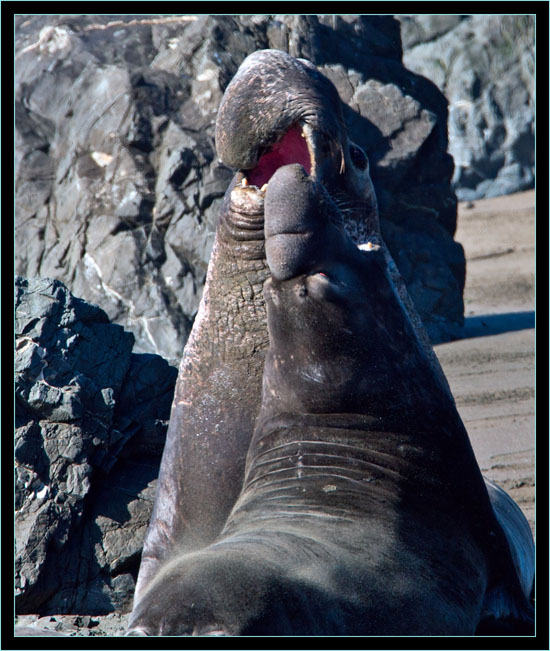
|
Pups in the Rookery...
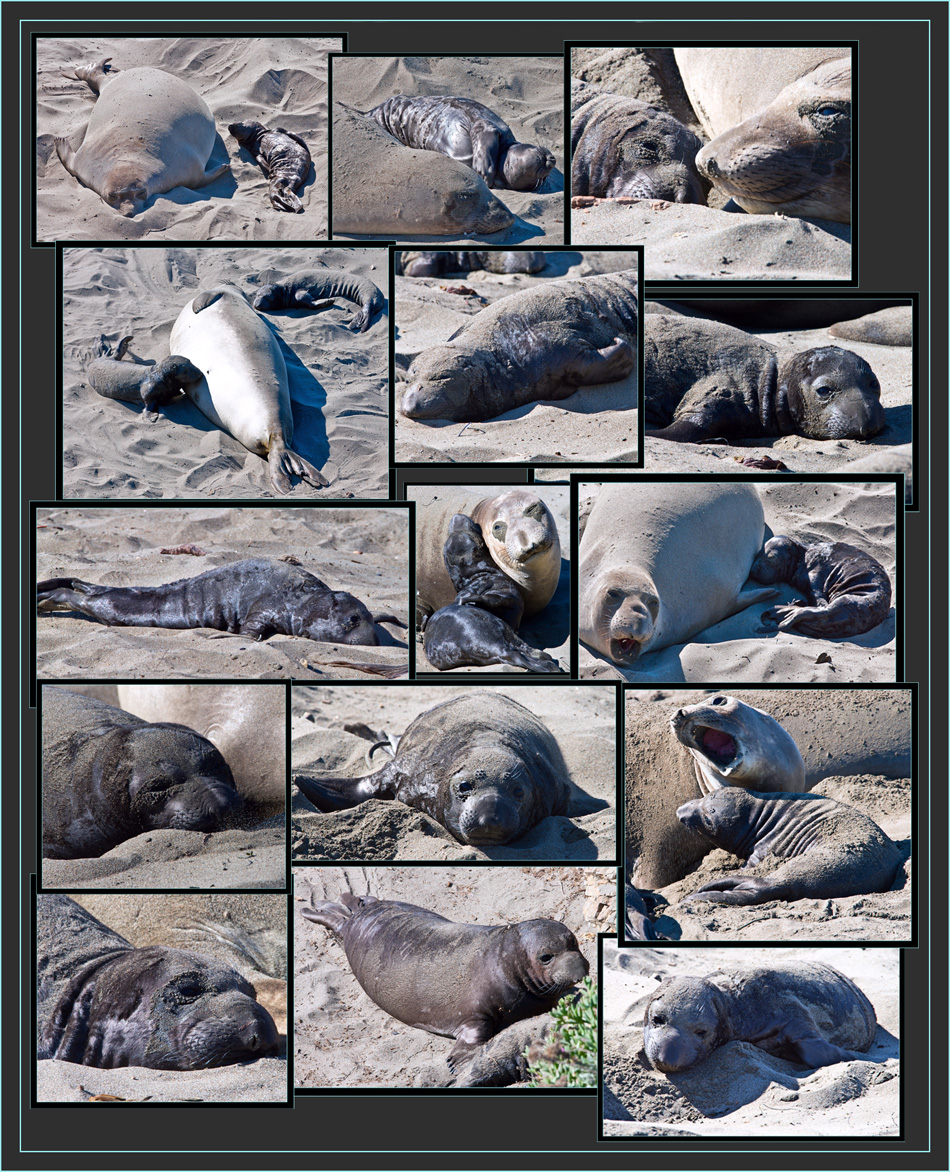
|
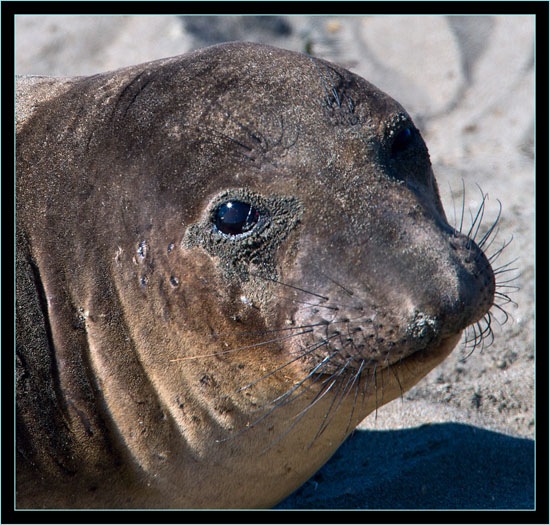
|
Bob and I stayed around the rookery for over two hours. This was enough time for the light conditions to soften and improve, between both cameras I exposed a large image group, including many sequence shots on the
1D X, but it was time to move on. What is represented in this article is a small sampling from the overall image group. The seals are not especially active as they were there to rest, and I was more than satisfied with the results.
Even if you cannot make it to the rookery for a personal visit, I would recommend and urge you to investigate the website of the Friends of the Elephant Seal. This site contains a plethora of information, images and videos about these wonderful animals. I was extremely pleased to be able to add photographs of Elephant Seals to my archive of nature shots. For me it was a sterling opportunity and it would be for you as well. Elephant Seal - Piedras Blancas Rookery, CaliforniaCanon EOS 1D X, 1/640 second; EF600mm f/4L IS USM +1.4x at f/10, ISO 400 |
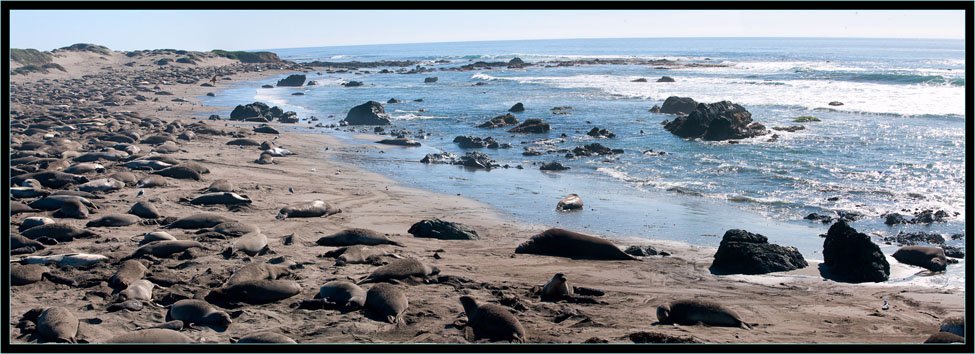
|

|
email me Home